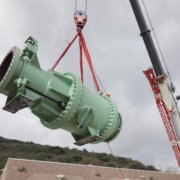Editor’s Note: This feature highlights new members of the San Diego County Water Authority’s 36-member Board of Directors. Each of the Water Authority’s 24 member agencies appoints at least one representative to the Board, which sets policy for the Water Authority.
Welcome to the Board: Ismahan Abdullahi, City of San Diego
Who: Ismahan Abdullahi was seated on the Board of Directors on January 25, 2021, representing the City of San Diego. Director Abdullahi serves on the Administrative and Finance and Engineering and Operations committees for the Water Authority.
Background/Education: Abdullahi earned her Bachelor’s degree in Human Biology at UC San Diego and a Master’s degree in Education with a concentration in counseling at San Diego State University. She serves as the Executive Director of MAS-PACE (Muslim American Society-Public Affairs and Civic Engagement). She also serves on the board of local community based organizations and institutions, with more than a decade of nonprofit experience.
Q & A
Q: How did you get interested in water issues?
A: Water is life itself. It is one of the key elements that is often taken for gratitude when it is available in abundance and sought after when it is limited. My interest in water issues is deeply personal. As a refugee from Somalia, I know the impact inadequately sanitized or treated water can have on families, introducing diseases such as cholera. We’ve seen how water contaminants and unsafe water (such as the water crisis in Flint, Michigan) has disproportionately impacted Indigenous, low-income and communities of color, particularly our Black and Brown communities. As a community advocate and organizer, I’ve seen the impact that rate increases and high water bills continue to further inequities in refugee, immigrant, and poverty stricken communities. My interest in water lies in my lived experience and over a decade of engaging in community work and seeing that impact firsthand.
Q: What are your priorities or interests as a Board member?
A: Policies and decisions made regarding water reliability, access, quality and safety have a direct impact on the lives of everyday San Diegans who are trying to thrive. I sincerely hope to bring an equity centered lens that honors both our environment and our communities. As a board member, I want us to bring forth creative solutions that meet the needs of our ratepayers and our region for generations to come. The COVID-19 crisis has further exacerbated the very inequities we knew existed before, leaving many San Diegans left with immensely high water bills. Equitable access to water, an inclusive and community centered space that prioritizes ratepayers and our environment and reliable and safe water for our future remain top priorities for me.
Q: Besides maintaining safe and reliable water supplies, what do you see as the top three issues facing the San Diego region?
A: Our region needs to adopt a racial equity framework in how it conducts business. In our region, we are facing a worsening housing crisis, climate emergency and the lack of a guaranteed living wage for the very people that are the backbone of our economy. We must be bold in our solutions and intersectional in facing our challenges. We cannot tackle our issues as a region without an intersectional equity framework.
Q: What do you like to do when you are not working?
A: My passion outside of working is to enjoy nature and reading. A nice walk at the beach, hike or quality time spent with loved ones in the outdoors is always a joy and a blessing.
The Water Authority’s Board of Directors typically meets on the fourth Thursday of each month. The Board invites the public to attend its monthly meetings and to comment on agenda items or other matters before the Board. For meeting times, agendas and documents, go to www.sdcwa.org/board-directors.




